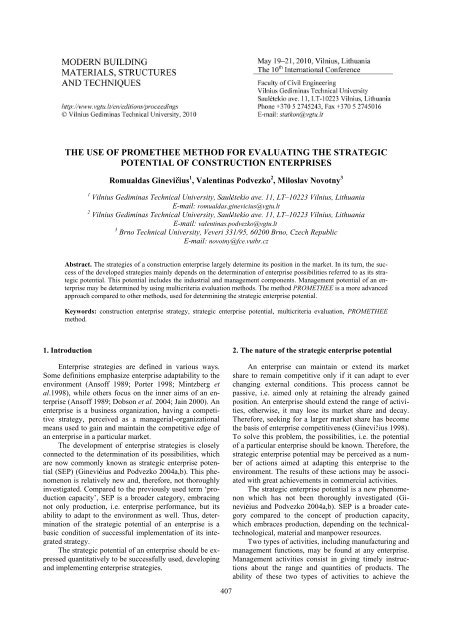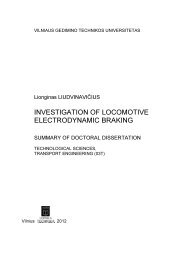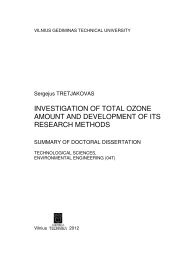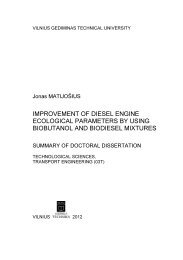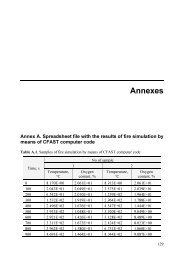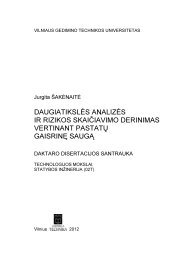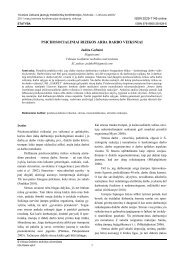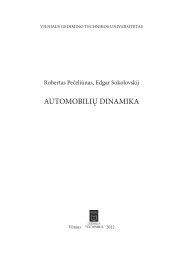the use of promethee method for evaluating the strategic potential of ...
the use of promethee method for evaluating the strategic potential of ...
the use of promethee method for evaluating the strategic potential of ...
Create successful ePaper yourself
Turn your PDF publications into a flip-book with our unique Google optimized e-Paper software.
Table 5. The numbers <strong>of</strong> preference functions <strong>of</strong> criteria and values <strong>of</strong> <strong>the</strong>ir parametersNo. Criterion Function No. min d max d q s1Ability to analyse macroeconomic situation in hostand <strong>for</strong>eign countries4 0.31 2.42 0.32 1.22Ability to determine in time <strong>the</strong> main needs <strong>of</strong> <strong>potential</strong>clients5 0.07 1.46 0.35 1.33Ability to analyse <strong>the</strong> demand <strong>for</strong> products and services,enabling an enterprise to supply <strong>the</strong> market with 2 0.13 0.73 0.13 0.4quality products in time4Ability to analyse factors <strong>of</strong> success and activity <strong>of</strong>rival groups in <strong>the</strong> market5 0.13 1.25 0.13 1.05Ability to generate new ideas in <strong>the</strong> field <strong>of</strong> developingand organizing production and providing new5 0.13 1.99 0.6 1.5competitive products and services6Ability to implement o<strong>the</strong>r new competitive ideas in<strong>the</strong> fields <strong>of</strong> producing new goods and providing new 4 0.05 2.52 0.65 1.9services7Ability to guarantee <strong>the</strong> development <strong>of</strong> <strong>the</strong> productivesystem <strong>of</strong> an enterprise and its flexibility5 0.03 0.75 0.14 0.758 Ability to maintain <strong>the</strong> competitive status <strong>of</strong> enterprise 2 0.24 2.0 0.8 2.09Ability to maintain inner flexibility in terms <strong>of</strong> providingadaptive technologies and o<strong>the</strong>r means2 0.17 0.78 0.4 0.7810Ability to maintain inner flexibility <strong>of</strong> <strong>the</strong> productivesystem by <strong>for</strong>ming human <strong>potential</strong> adequate to changing3 0 0.21 0.08 0.21objectives11Ability to maintain competitive ability in <strong>the</strong> prospectivemarkets4 0.13 1.05 0.3 0.912Ability to produce and supply products and services involumes corresponding to enterprise <strong>potential</strong> and5 0.02 0.91 0.15 0.7targeted market share13Ability to maintain effective enterprise per<strong>for</strong>manceby rational <strong>use</strong> <strong>of</strong> investment possibilities4 0.19 1.89 0.5 1.714Ability to plan and implement efficiently a <strong>strategic</strong>programme <strong>of</strong> technical and social development <strong>of</strong> anenterprise5 0.1 1.02 0.2 1.0The values <strong>of</strong> pairwise comparison relationship( A , A ) <strong>of</strong> four construction enterprises, <strong>the</strong> sums <strong>of</strong>πjkall positive (‘outcoming’) relationships F j+and negative(‘incoming’) relationships F j − , as well as <strong>the</strong> differencesbetween−<strong>the</strong>m F j F j − F j ( j 1,2,..., n ) and <strong>the</strong>=ranks <strong>of</strong> all considered enterprises, determined by + using<strong>the</strong> <strong>method</strong> PROMETHEE II, are given in Table = 6.As shown in Table 7, <strong>the</strong> <strong>method</strong>s SAW and TOPSISyield actually <strong>the</strong> same preference order <strong>of</strong> enterprises.We can also see that <strong>the</strong> PROMETHEE <strong>method</strong> gives <strong>the</strong>same ranks to <strong>the</strong> best and <strong>the</strong> worst enterprises as o<strong>the</strong>r<strong>method</strong>s. The actual differences can be found between <strong>the</strong>ranks in <strong>the</strong> middle <strong>of</strong> <strong>the</strong> preference order. However, <strong>the</strong>differences between <strong>the</strong> second- and <strong>the</strong> third-rankedenterprises calculated by <strong>the</strong> PROMETHEE <strong>method</strong> aremuch greater. There<strong>for</strong>e, it yields more accurate resultscompared to SAW and TOPSIS <strong>method</strong>s.Now, we can compare <strong>the</strong> results obtained by multicriteriaevaluation <strong>method</strong>s SAW, TOPSIS and PROME-THEE II (see Table 7).Table 6. The relationships ( A j , Ak)<strong>of</strong> pairwise comparison<strong>of</strong> construction enterprisesπ−1 2 3 4 F +1 − 0.534 0.174 0.085 0.7932 0.316 − 0.262 0.196 0.7753 0.127 0.495 − 0.086 0.7084 0.198 0.495 0.304 − 0.996F 0.641 1.524 0.740 0.367F 0.152 -0.750 -0.032 0.629Table 7. The results obtained in multicriteria evaluation <strong>of</strong>using <strong>the</strong> <strong>strategic</strong> <strong>potential</strong> <strong>of</strong> construction enterprisesMethodEnterprise1 2 3 4SAW 3 4 2 1TOPSIS 3 4 2 1PROMETHEE II 2 4 3 1411
ConclusionsThe market share <strong>of</strong> a construction enterprise reflectsits competitive ability. To retain and extend itsmarket share, a company should have <strong>the</strong> effective strategy.The development <strong>of</strong> this strategy is closely connectedto <strong>the</strong> determination <strong>of</strong> enterprise possibilities.The possibilities related to <strong>the</strong> production and managementactivities, associated with <strong>the</strong> manufacture <strong>of</strong> goodsand <strong>the</strong>ir selling in <strong>the</strong> market, may be referred to as <strong>the</strong><strong>strategic</strong> <strong>potential</strong> <strong>of</strong> an enterprise.Production capacity <strong>of</strong> an enterprise, depending on<strong>the</strong> available equipment, manpower, etc., determines <strong>the</strong>amount <strong>of</strong> goods that an enterprise can manufacture. Theproblem <strong>of</strong> quantitative evaluation <strong>of</strong> management possibilitieshas not been thoroughly investigated. Since <strong>the</strong>sepossibilities are multifaceted, multicriteria <strong>method</strong>s arewell suited <strong>for</strong> <strong>the</strong>ir complex evaluation. The calculationsmade by applying <strong>the</strong> <strong>method</strong>s <strong>of</strong> <strong>the</strong> geometric mean,SAW and TOPSIS yielded diverse results. These estimateswere checked by <strong>the</strong> <strong>method</strong> PROMETHEE, allowing <strong>the</strong>researchers to consider <strong>the</strong> value <strong>of</strong> any criterion describing<strong>the</strong> research object, to choose a respective preferencefunction <strong>for</strong> it and to determine <strong>the</strong> parameters <strong>of</strong> <strong>the</strong>sefunctions, depending on <strong>the</strong> criteria values.ReferencesAns<strong>of</strong>f, I. H. 1989. Corporate Strategy. Revised edition. Penguin,Harmondsworth.Behzadian, M.; Kazemzadeh, R. B.; Albadvi, A.; Aghdasi, M.2010. PROMETHEE: A comprehensive literature reviewon <strong>method</strong>ologies and applications, European Journal <strong>of</strong>Operational Research 200(1): 198–215.doi:10.1016/j.ejor.2009.01.021Brans, J.-P.; Mareschal, B. 1992. PROMETHEE-V – MCDMproblems with segmentation constraints, INFOR 30(2):85–96.Brans, J.-P.; Mareschal, B. 1994. The PROMETHEE-GAIAdecision support system <strong>for</strong> multicriteria investigations,Investigation Operativa 4(2): 107–117.Brans, J.-P.; Mareschal, B. 1996. The PROMETHEE-VI procedure.How to differentiate hard from s<strong>of</strong>t multicriteriaproblems, Journal <strong>of</strong> Decision Systems 4: 213–223.Brans, J.-P.; Mareschal, B. 2005. PROMETHEE <strong>method</strong>s,in‘Multiple Criteria Decision Analysis: State <strong>of</strong> <strong>the</strong> ArtSurveys’ Edited by J.Figueira, S.Greco, M.Ehrgott.Springer, Chapter 5:163–195.Dobson, P.; Starkey, K.; Richards, J. 2004. Strategic Management:Issues and Cases. Ox<strong>for</strong>d: Blackwell Publishing.Ginevičius, R. 1998. Diversification <strong>of</strong> enterprise activities.Vilnius, Technika.Ginevičius, R. 2008. Normalization <strong>of</strong> quantities <strong>of</strong> variousdimensions, Journal <strong>of</strong> Business Economics and Management9(1): 79–86. doi:10.3846/1611-1699.2008.9.79-86Ginevičius, R.; Podvezko, V. 2004a. Quantitative evaluation <strong>of</strong><strong>the</strong> <strong>strategic</strong> <strong>potential</strong> <strong>of</strong> enterprises, Business: Theory andPractice 5(1): 3–9.Ginevicius, R.; Podvezko, V. 2004b. Determination <strong>of</strong> weightiness<strong>of</strong> <strong>the</strong> hierarchically-structured organization accordingto its commercial activity. Foundations <strong>of</strong> civil andenvironmental engineering, 5: 21-33.Ginevicius, R.; Podvezko, V. 2006a. Comprehensive evaluation<strong>of</strong> economic and social development <strong>of</strong> Lihuanian regionsbased on a structured set <strong>of</strong> criteria, in Proc. <strong>of</strong> <strong>the</strong> 4 th InternationalConference Citizens and Governance <strong>for</strong> SustainableDevelopment SIGCUD’2006, September 28-30,2006. Vilnius, Lithuania. Vilnius: Technika, 194–199.Ginevicius, R.; Podvezko, V. 2006b. The uncertainty factor inmulticriteria analysis, in Proc. <strong>of</strong> <strong>the</strong> International Conferenceon Optimal Research „Simulation and Optimizationin Business and Industry“, May 17-20, 2006. Tallinn,136–140.Ginevicius, R.; Martinkute R.; Podvezko, V. 2006c. MulticriteriaDecisions in Capital Markets. WMSCI 2006: In Proc.<strong>of</strong> <strong>the</strong> 10th World Multi-Conference on Systemics, Cyberneticsand In<strong>for</strong>matics/ 12 th International Conference <strong>of</strong>In<strong>for</strong>mation Systems Analysis and Syn<strong>the</strong>sis, Jul 16-19,2006. Orlando, Florida, Vol 1, Proceedings 36–39.Ginevicius, R.; Podvezko V. 2007a. The effect <strong>of</strong> complexevaluation <strong>the</strong> reliability <strong>of</strong> calculation results. In Proc. <strong>of</strong><strong>the</strong> 4 th International Scientific Conference Business andManagement’2006. In The 14 th International ScientificConference Enterprise Management: Diagnosis, Strategy,Efficiency. Selected papers. October 5-6, 2006. Vilnius,Lithuania: 27-30.Ginevičius R.; Podvezko V. 2007b. The influence <strong>of</strong> complexevaluation <strong>method</strong>s on rating <strong>the</strong> alternative operations <strong>of</strong>wall insulation, in Proc. <strong>of</strong> <strong>the</strong> 9 th International ConferenceModern building materials structures and techniques.Mai 16-18, 2007. Vilnius, Lithuania. Selected papers,vol.1, 248–251.Ginevicius, R.; Podvezko, V. 2008a. Multicriteria evaluation <strong>of</strong>Lithuanian banks from <strong>the</strong> perspective <strong>of</strong> <strong>the</strong>ir reliability<strong>for</strong> clients, Journal <strong>of</strong> Business Economics and Management9(4): 257–267.doi:10.3846/1611-1699.2008.9.257-267Ginevičius, R.; Podvezko, V. 2008b. Housing in <strong>the</strong> context <strong>of</strong>economic and social development <strong>of</strong> Lithuanian regions,Int. J. Environment and Pollution 35(2/3/4): 309–330.Ginevičius, R.; Podvezko, V. 2009. Evaluating <strong>the</strong> changes ineconomic and social development <strong>of</strong> Lithuanian countiesby multiple criteria <strong>method</strong>s, Technological and EconomicDevelopment <strong>of</strong> Economy 15(3): 418–436.doi:10.3846/1392-8619.2009.15.418-436Ginevicius, R.; Martinkute, R.; Podvezko, V. 2006a. MulticriteriaDecisions in Capital Markets, in Proc. <strong>of</strong> <strong>the</strong> WMSCI2006: 10th World Multi-Conference on Systemics, Cyberneticsand In<strong>for</strong>matics, Proceedings 1: 36–40.Ginevičius, R.; Butkevičius, A.; Podvezko, V. 2006b. ComplexEvaluation <strong>of</strong> Economic Development <strong>of</strong> <strong>the</strong> Baltic Statesand Poland, Ekonomický Časopis 54(9): 918–930.Ginevičius, R.; Podvezko, V.; Bruzgė, Š. 2008a. Evaluating <strong>the</strong>Effect <strong>of</strong> State Aid to Business by Multicriteria Methods,Journal <strong>of</strong> Business Economics and Management 9(3):167–180. doi:10.3846/1611-1699.2008.9.167-180Ginevičius, R.; Podvezko, V.; Raslanas, S. 2008b. Evaluating<strong>the</strong> Alternative Solutions <strong>of</strong> Wall Insulation by MulticriteriaMethods, Journal <strong>of</strong> Civil Engineering and Management14(4): 217–226. doi:10.3846/1392-3730.2008.14.20Gorfinkel, V. Y.; Shvandar, V. A. 2000. Enterprise economics.Moscow, INITI−DANA (in Russian).412
Jain, S. C. 2000. Marketing Planning and Strategy, 6 th Ed.,South-Western College Publishing.Khripach, I. Y.; Susha, G. Z.; Onopriyenko, G. K. 2001. Enterpriseeconomics. Minsk, Econompress (in Russian).Maskeliūnaitė, L.; Sivilevičius, H.; Podvezko, V. 2009. Researchon <strong>the</strong> quality <strong>of</strong> passenger transportation by railway,Transport 24(2): 100–112.doi:10.3846/1648-4142.2009.24.100-112Mintzberg, H.; Ahlstrand, B.; Lampel, J. 1998. Strategy Safari.A Guided Tour through <strong>the</strong> Wilds <strong>of</strong> Strategic Management.New York: The Free Press.Podvezko, V. 2008. Comprehensive evaluation <strong>of</strong> complexquantities, Business: Theory and Practice 9(3): 160–168.doi:10.3846/1648-0627.2008.9.160-168Podvezko, V. 2009. Application <strong>of</strong> AHP technique, Journal <strong>of</strong>Business Economics and Management 10(2): 181–189.doi:10.3846/1611-1699.2009.10.181-189Podvezko, V.; Podviezko, A. 2009. PROMETHEE I <strong>method</strong>application <strong>for</strong> identification <strong>of</strong> <strong>the</strong> best alternative, Business:Theory and Practice 10(2): 84–92.doi:10.3846/1648-0627.2009.10.84-92Podvezko, V.; Podviezko, A. 2010. Dependence <strong>of</strong> multicriteriaevaluation result on choice <strong>of</strong> preference functionsand <strong>the</strong>ir parameters, Technological and Economic Development<strong>of</strong> Economy 16(1): 143–158.doi:10.3846/tede.2010.09Porter, M. 1998. Competitive Strategy: Technigues <strong>for</strong> AnalyzingIndustries and Competitors. New York: The FreePress.Raitskij, K. A. 2002. Enterprise economics. Moscow, TradeCorporation „Dashkov & C“ (in Russian).Saaty, T. L. 1980. The Analytic Hierarchy Process. M.Graw-Hill, New York.Saaty, T. L. 2005. The Analytic Hierarchy and Analytic NetworkProcesses <strong>for</strong> <strong>the</strong> Measurement <strong>of</strong> Intangible Criteriaand <strong>for</strong> Decision-Making, in ‘Multiple Criteria DecisionAnalysis: State <strong>of</strong> <strong>the</strong> Art Surveys’. Edited by J.Figueira,S.Greco, M.Ehrgott. Springer, Chapter 9: 345–408.Zavadskas, E. K.; Kaklauskas, A.; Banaitis, A.; Kvederytė, N.2004. Housing credit access model: <strong>the</strong> case <strong>for</strong> Lithuania,European Journal <strong>of</strong> Operation Research 155 (2): 335–352. doi:10.1016/S0377-2217(03)00091-2Zavadskas, E. K.; Kaklauskas, A.; Peldschus, F.; Turskis, Z.2007. Multiattribute assessment <strong>of</strong> road design solutionsby applying COPRAS <strong>method</strong>. The Baltic Journal <strong>of</strong>Road and Bridge Engineering, 2 (4): 195-203.Zavadskas, E.K.; Kaklauskas, A.; Turskis, Z.; Tamošaitienė, J.2008a. Selection <strong>of</strong> <strong>the</strong> effective dwelling ho<strong>use</strong> walls byapplying attributes values determined at intervals, Journal<strong>of</strong> Civil Engineering and Management 14(2): 85–93.doi:10.3846/1392-3730.2008.14.3Zavadskas, E.K.; Turskis, Z.; Tamošaitienė, J. Marina, V.2008b. Multicriteria Selection <strong>of</strong> Project Managers byApplying grey Criteria, Technological and Economic Development<strong>of</strong> Economy 14(4): 462–477.doi:10.3846/1392-8619.2008.14.462-477Zavadskas, E.K.; Kaklauskas, A.; Turskis, Z.; Tamošaitienė, J.2009. Multi-attribute decision- making model by applyinggrey numbers, In<strong>for</strong>matica 20(2): 305–320.413


